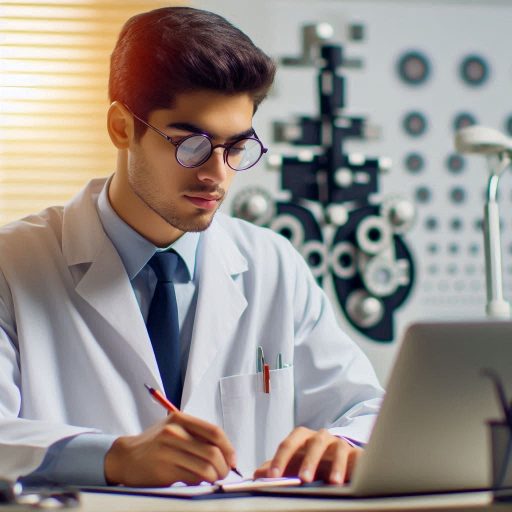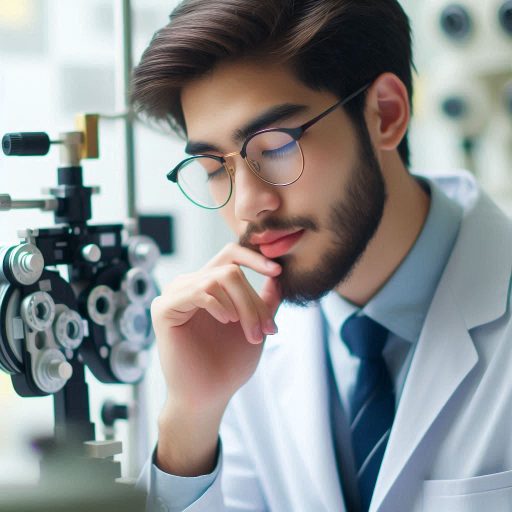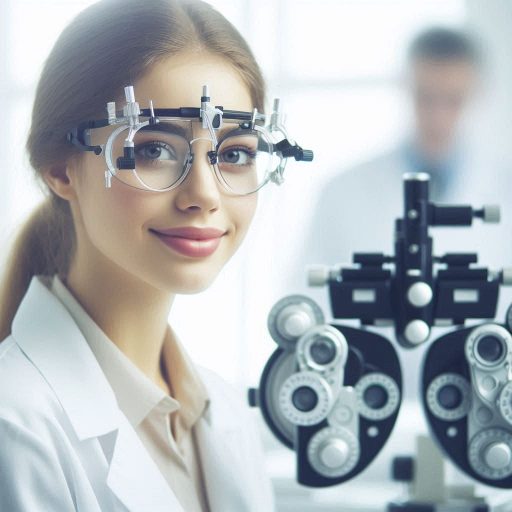Introduction
Tools and equipment play a crucial role in optometry practice.
They enhance the precision and efficiency of eye examinations.
Advanced equipment has revolutionized how optometrists diagnose and treat eye conditions.
Modern optometric tools allow for more accurate assessments of visual health.
These advancements improve patient outcomes and streamline various processes.
By utilizing innovative technology, optometrists can provide better care for their patients.
Today‘s equipment helps detect conditions early, allowing for timely interventions.
This proactive approach enhances overall eye health and prevents vision loss.
Patients benefit from accurate diagnoses and personalized treatment plans tailored to their needs.
The right tools also enhance the patient experience.
They allow for thorough examinations and foster trust between patients and optometrists.
Patients feel confident knowing their eye care is in skilled hands.
In this blog, we will explore the specific tools and equipment used by optometrists.
We will discuss essential examination tools, diagnostic equipment, refraction tools, and more.
Each tool plays a vital role in providing comprehensive eye care.
Understanding these tools will help appreciate the advancements in optometry practice today.
Essential Examination Tools
Optometrists rely on various essential examination tools to assess patients’ eye health.
These tools help diagnose conditions, prescribe corrective lenses, and monitor ongoing eye health.
Some of the most critical tools include ophthalmoscopes and retinoscopes.
Description of Tools Like Ophthalmoscopes and Retinoscopes Used for Eye Examinations
Ophthalmoscopes allow optometrists to examine the interior of the eye.
This handheld device features a light source and lenses that magnify the view of the retina.
Optometrists use ophthalmoscopes to identify abnormalities, such as retinal tears, diabetic retinopathy, and macular degeneration.
By examining the retina, optometrists can evaluate blood vessels, optic nerve health, and signs of systemic diseases.
Retinoscopes help optometrists determine a patient’s refractive error.
This tool shines a light into the eye and assesses the reflection off the retina.
Optometrists observe how the light moves and changes as they adjust the lenses.
This process allows them to determine the proper prescription for glasses or contact lenses.
Retinoscopy is especially valuable for patients who may struggle with traditional vision tests, such as children or individuals with communication difficulties.
Using these tools effectively requires thorough training.
Optometrists learn to interpret the data these instruments provide.
The accuracy of their assessments relies heavily on the proper use of these tools.
How These Tools Help Optometrists Assess the Health of the Eyes
Regular maintenance and calibration of examination tools are crucial for accurate assessments.
Over time, equipment may become misaligned or less effective.
Routine checks ensure that each tool operates optimally and provides precise readings.
Calibration verifies that measurements remain consistent and reliable.
Neglecting these tasks can lead to misdiagnoses or inappropriate treatments.
In addition to ophthalmoscopes and retinoscopes, optometrists also use other examination tools.
Tonometers measure intraocular pressure, helping detect glaucoma.
Visual field testers assess peripheral vision, which is essential for diagnosing various eye conditions.
Slit lamps provide a magnified view of the front part of the eye, allowing optometrists to examine the cornea, iris, and lens.
Each of these tools plays a significant role in eye care.
They contribute to a comprehensive examination, allowing optometrists to develop effective treatment plans.
By utilizing advanced examination tools, optometrists can provide high-quality care.
Importance of Regular Maintenance and Calibration of Examination Tools
Essential examination tools like ophthalmoscopes and retinoscopes are vital in optometry.
They enable optometrists to assess and diagnose various eye conditions accurately.
Regular maintenance and calibration ensure these tools remain effective, ultimately benefiting patients‘ eye health.
Optometrists must stay updated on best practices for using and maintaining these essential tools.
Read: Profiles in Success: Leading Chemists of the 21st Century in the US
Diagnostic Equipment
Optometrists utilize advanced diagnostic equipment to enhance patient care.
This equipment helps identify various eye conditions, ensuring timely treatment.
Two essential tools are tonometers and keratometers.
Introduction to Advanced Diagnostic Equipment Like Tonometers and Keratometers
Tonometers measure intraocular pressure (IOP).
This tool plays a crucial role in detecting glaucoma, a leading cause of blindness.
During the exam, optometrists apply a small amount of anesthetic eye drops.
They then use the tonometer to measure the pressure inside the eye.
The process is quick, non-invasive, and essential for glaucoma screening.
Keratometers measure the curvature of the cornea.
This tool assesses corneal shape and determines astigmatism severity.
Optometrists shine light on the cornea and analyze how it reflects.
The keratometer provides precise measurements that help in fitting contact lenses.
It also assists in diagnosing other corneal conditions, ensuring comprehensive eye assessments.
How These Tools Help Identify Eye Conditions Like Glaucoma and Astigmatism
Tonometers and keratometers provide crucial data that aids in diagnosis.
Elevated IOP readings from tonometers can indicate glaucoma.
Early detection is vital, as untreated glaucoma can lead to irreversible vision loss.
Optometrists can then develop appropriate treatment plans to manage the condition.
Keratometers are instrumental in diagnosing astigmatism.
By measuring corneal curvature, optometrists can determine the extent of the irregularity.
This information is essential for prescribing corrective lenses.
Accurate measurements help ensure patients receive the best possible vision correction.
Benefits of Early Detection Through the Use of Diagnostic Equipment
Early detection through diagnostic equipment has numerous benefits.
Identifying conditions like glaucoma and astigmatism promptly allows for timely intervention.
Treating these conditions early can prevent further complications and preserve vision.
For example, if glaucoma is detected early, optometrists can recommend medications or procedures to lower IOP.
These interventions can halt or slow the progression of the disease, preserving patients’ sight.
Similarly, detecting astigmatism early allows for timely fitting of corrective lenses.
This ensures patients achieve optimal vision without prolonged discomfort.
Additionally, regular eye exams that include diagnostic testing can identify other conditions.
Diseases such as diabetic retinopathy or macular degeneration may also be detected early.
This proactive approach to eye care enhances overall patient health.
Diagnostic equipment like tonometers and keratometers plays a vital role in optometry.
These tools assist in identifying eye conditions and ensuring timely treatment.
Early detection improves patient outcomes and preserves vision.
Optometrists must utilize these advanced diagnostic tools to provide the highest quality of care.
By doing so, they enhance their ability to protect and promote patients’ eye health.
Read: The Life and Times of a U.S. Physicist: A Day in Detail
Refraction Tools
Optometrists rely on various refraction tools to determine patients’ refractive errors.
Accurate refraction is essential for prescribing glasses or contact lenses.
Two common tools used in this process are phoropters and autorefractors.
Description of Tools Like Phoropters and Autorefractors Used for Determining Refractive Errors
Phoropters are essential devices used to measure a patient’s prescription for corrective lenses.
This tool contains a series of lenses that optometrists adjust during eye exams.
Patients look through the phoropter at an eye chart and provide feedback.
The optometrist then fine-tunes the lens selection until they achieve optimal vision clarity.
Autorefractors, on the other hand, use advanced technology to automate the refraction process.
This device shines light into the eye and analyzes how it reflects.
By measuring how light changes as it passes through the eye, the autorefractor determines the refractive error.
This process is quick and requires minimal patient input.
Importance of Accurate Refraction for Prescribing Glasses or Contact Lenses
Accurate refraction is critical for effective vision correction.
It ensures that patients receive the appropriate prescription for their glasses or contact lenses.
An inaccurate prescription can lead to discomfort, headaches, and blurred vision.
Therefore, optometrists must use reliable refraction tools to achieve precise results.
When patients have an accurate prescription, they experience improved visual clarity.
This enhancement significantly impacts their daily activities and overall quality of life.
For example, students can focus better in school, while professionals can perform their tasks efficiently.
Additionally, accurate refraction helps reduce eye strain and fatigue.
By providing the right prescription, optometrists support patients’ eye health and comfort.
Regular eye exams and precise refraction contribute to long-term vision health.
How Technology Has Improved the Accuracy and Speed of Refraction Tools
Technological advancements have significantly improved the accuracy and speed of refraction tools.
Modern autorefractors are faster and more precise than older models.
These advancements reduce the time spent on refraction during eye exams.
Moreover, many phoropters now feature digital displays and automated adjustments.
This technology allows for more accurate lens selection based on patient feedback.
As a result, optometrists can obtain precise measurements more efficiently.
Tele-optometry also enhances refraction capabilities.
Remote consultations enable optometrists to perform preliminary refraction tests through specialized software.
Patients can conduct self-tests at home and send results to their optometrists for evaluation.
Refraction tools like phoropters and autorefractors are essential in optometry.
Accurate refraction is vital for prescribing effective vision correction.
Advancements in technology have improved the accuracy and speed of these tools.
As a result, optometrists can provide better care and enhance patients’ overall visual experiences.
By utilizing these tools effectively, optometrists play a crucial role in maintaining patients’ eye health.
Read: Salary Ranges: What to Expect as a Physicist in the USA

Vision Testing Equipment
Optometrists use various vision testing equipment to evaluate patients’ visual functions.
These tools help identify potential vision problems and determine appropriate treatments.
Key equipment includes visual acuity charts and perimeters.
Overview of Equipment Like Visual Acuity Charts and Perimeters Used for Vision Testing
Visual acuity charts, such as the Snellen chart, are standard tools in eye exams.
They consist of rows of letters in varying sizes.
Patients stand a specific distance away and read the letters aloud.
This process measures how well each eye can see at a distance.
Perimeters are devices used to measure a patient‘s peripheral vision.
They assess the full range of vision, identifying blind spots and field loss.
Patients look into the perimeter and indicate when they see lights flash in their peripheral vision.
This test helps optometrists determine the health of the visual field.
How These Tools Help Optometrists Assess a Patient’s Visual Function
These tools play a crucial role in assessing visual function.
Visual acuity charts help identify refractive errors, such as nearsightedness or farsightedness.
By determining the sharpness of vision, optometrists can adjust prescriptions accordingly.
Perimeters help detect eye conditions like glaucoma or retinal diseases.
Loss of peripheral vision can indicate serious issues requiring immediate attention.
These assessments allow optometrists to create comprehensive treatment plans tailored to patients’ needs.
Importance of Regular Vision Testing for Maintaining Eye Health
Regular vision testing is essential for maintaining eye health.
It helps detect vision problems early, enabling prompt treatment.
Undiagnosed vision issues can lead to further complications, impacting overall health and quality of life.
Frequent eye exams also ensure prescriptions are up to date.
As people age, their vision can change, requiring adjustments to eyewear.
Regular testing allows optometrists to monitor these changes and make necessary modifications.
Additionally, vision testing contributes to early detection of systemic diseases.
Conditions like diabetes or hypertension can manifest through changes in vision.
By regularly assessing visual function, optometrists can identify potential health risks and refer patients to appropriate specialists.
Parents should prioritize regular eye exams for their children.
Early detection of vision issues can significantly impact academic performance and development.
Ensuring children receive routine vision testing fosters lifelong eye health and wellness.
Vision testing equipment is vital for evaluating visual function.
Tools like visual acuity charts and perimeters enable optometrists to assess patients effectively.
Regular vision testing plays a crucial role in maintaining eye health and detecting potential issues early.
By utilizing these tools, optometrists ensure patients receive optimal care and support for their visual needs.
Transform Your Career Today
Unlock a personalized career strategy that drives real results. Get tailored advice and a roadmap designed just for you.
Start NowRead: Physics Specializations: Choosing Your Path in the U.S.
Contact Lens Fitting Tools
Optometrists rely on specialized tools for fitting contact lenses.
Proper fitting ensures comfort, optimal vision, and overall patient satisfaction.
Key tools include corneal topographers and contact lens trial sets.
Description of Tools Like Corneal Topographers and Contact Lens Trial Sets Used for Fitting Contact Lenses
Corneal topographers map the curvature of the cornea.
They create detailed, three-dimensional images that help optometrists understand the corneal shape.
This data is crucial for fitting contact lenses accurately.
Contact lens trial sets contain various lenses for patient evaluation.
Optometrists use these sets to find the best fit for individual patients.
Trial lenses allow practitioners to assess comfort and visual acuity before finalizing a prescription.
Importance of Proper Fitting for Comfort and Visual Acuity
Proper fitting is essential for contact lens success.
Ill-fitting lenses can cause discomfort, leading to irritation or even injury.
They may also reduce visual acuity, negatively impacting patients‘ daily lives.
Comfort plays a significant role in patient adherence.
Patients are more likely to wear their lenses regularly if they feel comfortable.
Properly fitted lenses enhance overall satisfaction and improve long-term usage.
Visual acuity is equally important.
Correctly fitted lenses provide sharp, clear vision.
They should align properly with the cornea, ensuring optimal optical performance.
Accurate fitting prevents issues like blurred vision or distorted images.
How Technology Has Improved the Efficiency and Accuracy of Contact Lens Fitting Tools
Advancements in technology have revolutionized contact lens fitting.
Modern corneal topographers provide detailed data quickly and accurately.
This allows optometrists to make informed decisions about lens options.
Digital contact lens fitting tools enable real-time assessments.
They streamline the fitting process, saving time for both practitioners and patients.
This efficiency improves the overall patient experience, enhancing satisfaction.
3D imaging technology offers enhanced visualizations of the cornea.
Optometrists can better understand corneal irregularities, leading to more precise fittings.
This technology improves the chances of successful contact lens wear for patients with complex corneal shapes.
Computerized fitting systems allow for more customization.
They analyze individual patient data, leading to personalized lens recommendations.
These systems ensure that every patient receives the best possible fit.
Additionally, new materials and designs in contact lenses enhance comfort.
Lenses now come with features like moisture retention and UV protection.
These advancements contribute to overall eye health and comfort during lens wear.
Contact lens fitting tools are vital for ensuring optimal patient care.
Tools like corneal topographers and trial sets help achieve accurate fittings.
Proper fitting promotes comfort and visual acuity, enhancing the patient experience.
Technological advancements further improve the efficiency and accuracy of fitting processes.
By utilizing these tools, optometrists can provide exceptional care to their patients and ensure successful contact lens wear.
Digital Imaging Equipment
Digital imaging equipment plays a crucial role in modern optometry.
These tools help optometrists capture detailed images of the eye.
Fundus cameras and optical coherence tomography (OCT) scanners are essential for diagnosing and monitoring eye conditions.
Introduction to Tools Like Fundus Cameras and Optical Coherence Tomography Scanners
Fundus cameras take high-resolution photographs of the retina.
They allow optometrists to visualize the internal structures of the eye.
These images help identify various eye diseases, including diabetic retinopathy and macular degeneration.
Optical coherence tomography (OCT) scanners use light waves to create cross-sectional images of the retina.
These images provide detailed views of the eye’s layers.
This technology allows for early detection of conditions like glaucoma and retinal disorders.
How These Images Help Diagnose and Monitor Eye Conditions
The images captured by these devices offer valuable diagnostic insights.
Fundus images allow optometrists to assess the optic nerve’s health and retinal blood vessels.
They can identify abnormalities and track changes over time.
OCT images provide detailed information about retinal thickness and structural changes.
This data helps in diagnosing conditions such as diabetic macular edema and age-related macular degeneration.
Regular monitoring allows optometrists to track disease progression and adjust treatment plans.
Accurate diagnosis relies on high-quality images.
Digital imaging tools enhance the optometrist’s ability to detect subtle changes in the eye.
Early detection significantly improves treatment outcomes and patient prognosis.
Benefits of Digital Imaging for Patient Education and Documentation
Digital imaging also aids in patient education.
High-quality images allow optometrists to explain eye conditions visually.
Patients can better understand their diagnosis and the importance of treatment options.
Sharing images during consultations fosters trust and transparency.
Patients feel more involved in their care when they see what the optometrist sees.
This engagement encourages compliance with treatment recommendations and follow-up appointments.
Furthermore, digital images serve as valuable documentation.
They provide a visual history of the patient’s eye health over time.
This information can be crucial for future evaluations and treatment decisions.
Digital imaging equipment also enhances the overall patient experience.
The non-invasive nature of these tools makes the process comfortable.
Patients appreciate the efficiency and accuracy that digital imaging brings to their eye exams.
Digital imaging equipment is vital in modern optometry.
Tools like fundus cameras and OCT scanners capture detailed images that aid in diagnosis.
These images help monitor eye conditions and facilitate patient education.
By improving communication and documentation, digital imaging enhances patient care and supports better outcomes.
Optometrists can provide more effective and informed care through these advancements.
Surgical Instruments
Surgical instruments are essential for performing delicate eye surgeries.
Optometrists and ophthalmologists rely on specialized tools for procedures like cataract surgery and refractive surgery.
Understanding these instruments is crucial for ensuring successful outcomes in eye care.
Overview of Specialized Instruments Used for Procedures Like Cataract Surgery and Refractive Surgery
Cataract surgery often requires specific instruments, such as phacoemulsification machines.
These machines use ultrasound waves to break up the cloudy lens.
Surgeons then use suction to remove the lens fragments.
This procedure restores clear vision for many patients.
Refractive surgery, like LASIK, utilizes different specialized tools.
Surgeons use microkeratomes or femtosecond lasers to create corneal flaps.
These instruments ensure precise cuts for effective reshaping of the cornea.
This reshaping helps correct vision problems like nearsightedness and farsightedness.
Other instruments, such as forceps and needle holders, assist surgeons during these procedures.
These tools allow for greater control and precision.
Surgeons use them to manipulate tissues and secure sutures effectively.
How These Instruments Help Surgeons Perform Delicate Eye Surgeries
Surgical instruments enhance the accuracy and safety of eye surgeries.
Phacoemulsification machines minimize the risk of damage to surrounding tissues.
Their design allows surgeons to focus on the affected lens while protecting the eye’s integrity.
Femtosecond lasers provide high precision during refractive surgeries.
They create consistent and accurate corneal flaps.
This precision leads to better visual outcomes and faster recovery times for patients.
The use of specialized instruments reduces the duration of surgeries.
Faster procedures often result in less anesthesia exposure for patients.
This efficiency contributes to overall patient safety and satisfaction.
Importance of Proper Sterilization and Maintenance of Surgical Instruments
Proper sterilization and maintenance of surgical instruments are critical for patient safety.
Sterilization eliminates potential infections during surgical procedures.
Surgeons must follow strict protocols to ensure all instruments are sterile before use.
Regular maintenance of instruments also ensures their functionality.
Dull blades or malfunctioning devices can compromise surgical outcomes.
Optometrists must routinely inspect and service their tools.
Proper training in instrument handling is essential for surgical teams.
Each team member must understand the importance of sterilization and maintenance.
This knowledge helps prevent complications during surgeries.
Surgical instruments play a vital role in eye care.
They enable optometrists and ophthalmologists to perform complex procedures safely and effectively.
Understanding their functions and the importance of sterilization can lead to better patient outcomes.
By ensuring instruments are well-maintained, eye care professionals can enhance surgical precision and patient safety.
Through continued education and adherence to protocols, the success of delicate eye surgeries can be significantly improved.
Explore Further: Microbiologist Salary: What to Expect in the USA
Conclusion
Tools and equipment are crucial in optometry practice.
They enhance the accuracy and efficiency of eye examinations and treatments.
Each type of equipment serves a unique purpose in patient care.
We discussed essential examination tools like ophthalmoscopes and retinoscopes.
Diagnostic equipment, such as tonometers and keratometers, helps identify conditions like glaucoma.
Refraction tools, including phoropters and autorefractors, are vital for determining refractive errors.
Vision testing equipment, like visual acuity charts, assesses patients‘ visual function.
Contact lens fitting tools ensure proper fit for comfort and visual acuity.
Digital imaging equipment captures detailed images of the eye for diagnosis and monitoring.
Finally, specialized surgical instruments facilitate delicate eye surgeries.
Optometrists should stay updated on advancements in technology.
New tools and equipment can improve patient care and treatment outcomes.
Embracing innovation enhances the overall quality of care and patient satisfaction.
Regular training and continuing education ensure optometrists maximize their skills and knowledge.
By doing so, they can provide the best possible care to their patients.
Staying informed about advancements in optometric tools fosters better patient outcomes and enhances professional growth.
This commitment to improvement will benefit both practitioners and their patients alike.
[E-Books for Sale]
The Big Book of 500 High-Paying Jobs in America: Unlock Your Earning Potential
$19.99 • 500 High-Paying Jobs • 330 pages
Explore 500 high-paying jobs in America and learn how to boost your career, earn more, and achieve success!
See All 500 High-Paying Jobs of this E-Book
1001 Professions Without a Degree: High-Paying American Jobs You Can Start Now
$19.99 • 1001 Professions Without a Degree • 174 pages
Discover 1001 high-paying jobs without a degree! Unlock career tips, skills, and success strategies for just $19.99!




